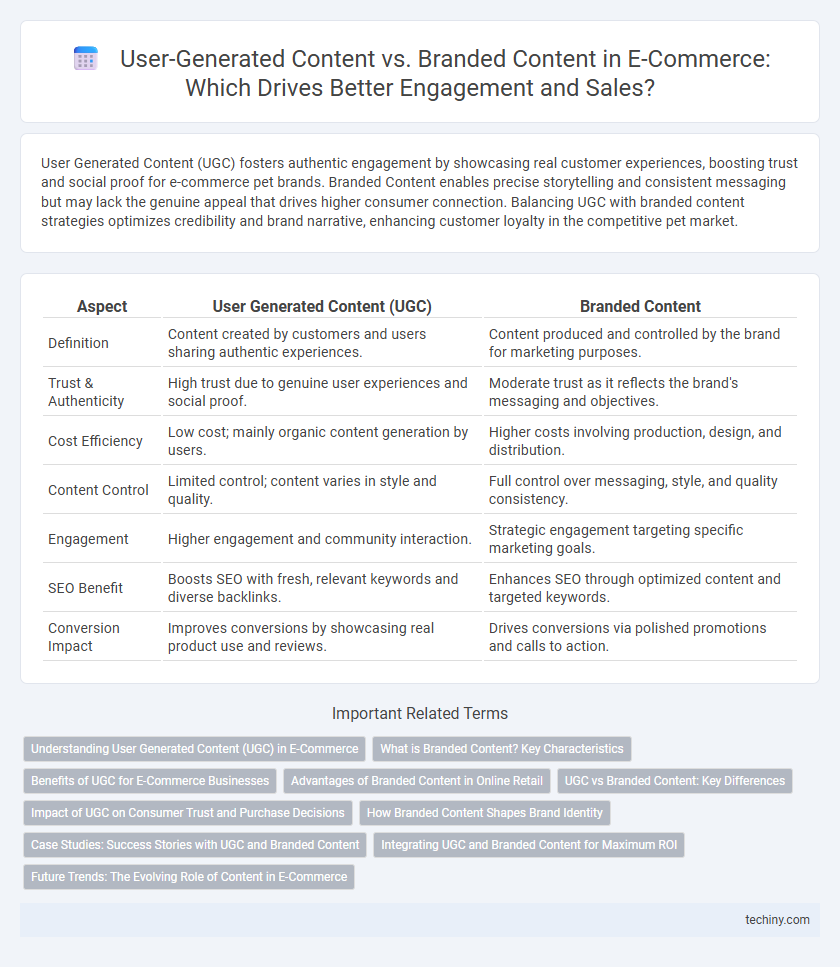User Generated Content (UGC) fosters authentic engagement by showcasing real customer experiences, boosting trust and social proof for e-commerce pet brands. Branded Content enables precise storytelling and consistent messaging but may lack the genuine appeal that drives higher consumer connection. Balancing UGC with branded content strategies optimizes credibility and brand narrative, enhancing customer loyalty in the competitive pet market.
Table of Comparison
| Aspect | User Generated Content (UGC) | Branded Content |
|---|---|---|
| Definition | Content created by customers and users sharing authentic experiences. | Content produced and controlled by the brand for marketing purposes. |
| Trust & Authenticity | High trust due to genuine user experiences and social proof. | Moderate trust as it reflects the brand's messaging and objectives. |
| Cost Efficiency | Low cost; mainly organic content generation by users. | Higher costs involving production, design, and distribution. |
| Content Control | Limited control; content varies in style and quality. | Full control over messaging, style, and quality consistency. |
| Engagement | Higher engagement and community interaction. | Strategic engagement targeting specific marketing goals. |
| SEO Benefit | Boosts SEO with fresh, relevant keywords and diverse backlinks. | Enhances SEO through optimized content and targeted keywords. |
| Conversion Impact | Improves conversions by showcasing real product use and reviews. | Drives conversions via polished promotions and calls to action. |
Understanding User Generated Content (UGC) in E-Commerce
User Generated Content (UGC) in e-commerce leverages authentic customer reviews, photos, and videos to enhance brand trust and drive purchase decisions. Unlike branded content, UGC offers organic, unbiased insights that resonate more deeply with prospective buyers by showcasing real user experiences. Integrating UGC into product pages and marketing campaigns significantly boosts engagement rates, conversion, and SEO performance by harnessing genuine consumer perspectives.
What is Branded Content? Key Characteristics
Branded content in e-commerce refers to promotional material created by a brand to engage audiences through storytelling that aligns with its values and products. Key characteristics include a consistent brand voice, high-quality visuals, and messaging designed to build brand awareness and emotional connections without overt sales pitches. This content strategically integrates product placement and brand identity to enhance customer loyalty and drive conversions.
Benefits of UGC for E-Commerce Businesses
User Generated Content (UGC) drives authentic engagement and builds trust by showcasing real customer experiences, significantly boosting conversion rates in e-commerce. UGC provides cost-effective marketing by leveraging customer-created photos, reviews, and testimonials, reducing reliance on expensive ad campaigns. This content also enhances SEO performance and social proof, increasing organic traffic and fostering brand loyalty.
Advantages of Branded Content in Online Retail
Branded content in online retail enhances product credibility and strengthens brand identity by delivering consistent, high-quality messages that align with the company's values and aesthetics. It allows retailers to control the narrative, ensuring messaging accuracy and fostering customer trust through professional storytelling and targeted campaigns. Leveraging branded content also boosts SEO performance by integrating strategic keywords and structured data, driving organic traffic and increasing conversion rates.
UGC vs Branded Content: Key Differences
User Generated Content (UGC) is created by customers and reflects authentic experiences, often driving higher trust and engagement compared to Branded Content, which is produced by the company to control messaging. UGC tends to showcase genuine reviews, photos, and videos, enhancing social proof, while Branded Content focuses on polished storytelling and promotional campaigns. Brands leveraging UGC benefit from increased consumer credibility and organic reach, whereas Branded Content provides consistent brand voice and strategic marketing control.
Impact of UGC on Consumer Trust and Purchase Decisions
User Generated Content (UGC) significantly enhances consumer trust by providing authentic, relatable experiences that branded content often lacks. Studies show that 79% of consumers trust UGC more than traditional advertising, directly influencing their purchase decisions and increasing conversion rates by up to 20%. Incorporating UGC into e-commerce platforms boosts engagement, fosters community loyalty, and drives higher sales through genuine social proof.
How Branded Content Shapes Brand Identity
Branded content plays a crucial role in shaping brand identity by delivering consistent messaging, visual aesthetics, and tone that align with the company's core values and target audience preferences. It establishes a cohesive narrative that differentiates the brand in a competitive e-commerce landscape, enhancing recognition and trust among consumers. Unlike user-generated content, branded content allows for strategic control over brand storytelling, ensuring alignment with long-term marketing objectives and brand positioning.
Case Studies: Success Stories with UGC and Branded Content
Case studies reveal that User Generated Content (UGC) drives 29% higher conversion rates by leveraging authentic customer experiences, while branded content establishes consistent brand messaging and identity. Brands like Glossier and Starbucks have successfully harnessed UGC to build community trust and engagement, yielding increased sales and brand loyalty. Conversely, companies such as Apple rely on polished branded content to maintain premium positioning and control over brand narrative.
Integrating UGC and Branded Content for Maximum ROI
Integrating User Generated Content (UGC) with branded content enhances e-commerce ROI by combining authentic consumer trust with strategic brand messaging. UGC drives higher engagement rates and conversion by showcasing real customer experiences, while branded content ensures consistent brand identity and targeted marketing objectives. Leveraging data analytics to blend these content types enables personalized campaigns that boost customer retention and optimize advertising spend efficiency.
Future Trends: The Evolving Role of Content in E-Commerce
User Generated Content (UGC) is increasingly driving trust and authenticity in e-commerce, with 79% of consumers saying UGC highly impacts their purchasing decisions. Branded content remains essential for maintaining brand identity but is shifting towards more interactive and personalized formats powered by AI and AR technologies. Future trends indicate a convergence where UGC and branded content blend seamlessly, leveraging data analytics to create immersive shopping experiences that boost engagement and conversion rates.
User Generated Content (UGC) vs Branded Content Infographic

 techiny.com
techiny.com